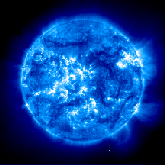| Model atmospheres
|
|
|
Stellar model atmospheres are one of the most important components
for stellar analysis over the whole range of stellar temperatures
and evolutionary stages. Apart from very few nearby stars our
knowledge about stellar parameters such as temperature, mass, chemical
composition and age are determined by comparing observed stellar
properties such as spectra or broad band colors to model predictions.
Over the past decades several approaches for the calculation of stellar model atmospheres have been developed. |
 |
|
This "evolution" in
model atmosphere calculation has been driven by the enormous increase
in the quality of observational data (CCD spectroscopy), the
vast increase of computation power and the progress
in the field of atomic data needed to calculate especially the
absorption properties of the stellar atmospheric environment.
Whilst "simple" grey models are only rarely used today there are in principal two ways to treat the problem of absorption in the atmospheric layers of a star. The first one is based on Opacity Distribution Functions(ODF) and treats bound-free absorptions based on labels. The second one is the Opacity Sampling(OS) approach that tries to treat all absorption features in a statistically "complete" way. Whilst the first approach allows fast computations of even small-meshed grids of models, the second one is much more time consuming, but more flexible in the sense, that individual element mixtures (adopted to the star analyzed) can be used. In principal the second approach allows to account for deviations from the assumption of local thermal equilibrium (LTE) as is partly done by the PHOENIX code. |
|